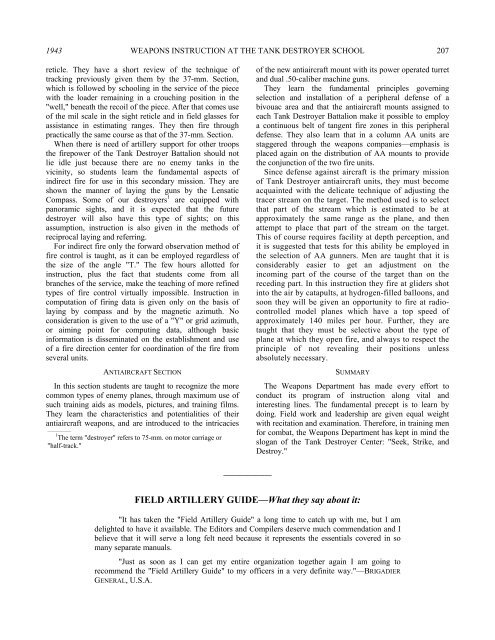the field artillery journal - Fort Sill - U.S. Army
the field artillery journal - Fort Sill - U.S. Army
the field artillery journal - Fort Sill - U.S. Army
You also want an ePaper? Increase the reach of your titles
YUMPU automatically turns print PDFs into web optimized ePapers that Google loves.
1943 WEAPONS INSTRUCTION AT THE TANK DESTROYER SCHOOL 207<br />
reticle. They have a short review of <strong>the</strong> technique of<br />
tracking previously given <strong>the</strong>m by <strong>the</strong> 37-mm. Section,<br />
which is followed by schooling in <strong>the</strong> service of <strong>the</strong> piece<br />
with <strong>the</strong> loader remaining in a crouching position in <strong>the</strong><br />
"well," beneath <strong>the</strong> recoil of <strong>the</strong> piece. After that comes use<br />
of <strong>the</strong> mil scale in <strong>the</strong> sight reticle and in <strong>field</strong> glasses for<br />
assistance in estimating ranges. They <strong>the</strong>n fire through<br />
practically <strong>the</strong> same course as that of <strong>the</strong> 37-mm. Section.<br />
When <strong>the</strong>re is need of <strong>artillery</strong> support for o<strong>the</strong>r troops<br />
<strong>the</strong> firepower of <strong>the</strong> Tank Destroyer Battalion should not<br />
lie idle just because <strong>the</strong>re are no enemy tanks in <strong>the</strong><br />
vicinity, so students learn <strong>the</strong> fundamental aspects of<br />
indirect fire for use in this secondary mission. They are<br />
shown <strong>the</strong> manner of laying <strong>the</strong> guns by <strong>the</strong> Lensatic<br />
Compass. Some of our destroyers 1 are equipped with<br />
panoramic sights, and it is expected that <strong>the</strong> future<br />
destroyer will also have this type of sights; on this<br />
assumption, instruction is also given in <strong>the</strong> methods of<br />
reciprocal laying and referring.<br />
For indirect fire only <strong>the</strong> forward observation method of<br />
fire control is taught, as it can be employed regardless of<br />
<strong>the</strong> size of <strong>the</strong> angle "T." The few hours allotted for<br />
instruction, plus <strong>the</strong> fact that students come from all<br />
branches of <strong>the</strong> service, make <strong>the</strong> teaching of more refined<br />
types of fire control virtually impossible. Instruction in<br />
computation of firing data is given only on <strong>the</strong> basis of<br />
laying by compass and by <strong>the</strong> magnetic azimuth. No<br />
consideration is given to <strong>the</strong> use of a "Y" or grid azimuth,<br />
or aiming point for computing data, although basic<br />
information is disseminated on <strong>the</strong> establishment and use<br />
of a fire direction center for coordination of <strong>the</strong> fire from<br />
several units.<br />
ANTIAIRCRAFT SECTION<br />
In this section students are taught to recognize <strong>the</strong> more<br />
common types of enemy planes, through maximum use of<br />
such training aids as models, pictures, and training films.<br />
They learn <strong>the</strong> characteristics and potentialities of <strong>the</strong>ir<br />
antiaircraft weapons, and are introduced to <strong>the</strong> intricacies<br />
—————<br />
1<br />
The term "destroyer" refers to 75-mm. on motor carriage or<br />
"half-track."<br />
——————<br />
of <strong>the</strong> new antiaircraft mount with its power operated turret<br />
and dual .50-caliber machine guns.<br />
They learn <strong>the</strong> fundamental principles governing<br />
selection and installation of a peripheral defense of a<br />
bivouac area and that <strong>the</strong> antiaircraft mounts assigned to<br />
each Tank Destroyer Battalion make it possible to employ<br />
a continuous belt of tangent fire zones in this peripheral<br />
defense. They also learn that in a column AA units are<br />
staggered through <strong>the</strong> weapons companies—emphasis is<br />
placed again on <strong>the</strong> distribution of AA mounts to provide<br />
<strong>the</strong> conjunction of <strong>the</strong> two fire units.<br />
Since defense against aircraft is <strong>the</strong> primary mission<br />
of Tank Destroyer antiaircraft units, <strong>the</strong>y must become<br />
acquainted with <strong>the</strong> delicate technique of adjusting <strong>the</strong><br />
tracer stream on <strong>the</strong> target. The method used is to select<br />
that part of <strong>the</strong> stream which is estimated to be at<br />
approximately <strong>the</strong> same range as <strong>the</strong> plane, and <strong>the</strong>n<br />
attempt to place that part of <strong>the</strong> stream on <strong>the</strong> target.<br />
This of course requires facility at depth perception, and<br />
it is suggested that tests for this ability be employed in<br />
<strong>the</strong> selection of AA gunners. Men are taught that it is<br />
considerably easier to get an adjustment on <strong>the</strong><br />
incoming part of <strong>the</strong> course of <strong>the</strong> target than on <strong>the</strong><br />
receding part. In this instruction <strong>the</strong>y fire at gliders shot<br />
into <strong>the</strong> air by catapults, at hydrogen-filled balloons, and<br />
soon <strong>the</strong>y will be given an opportunity to fire at radiocontrolled<br />
model planes which have a top speed of<br />
approximately 140 miles per hour. Fur<strong>the</strong>r, <strong>the</strong>y are<br />
taught that <strong>the</strong>y must be selective about <strong>the</strong> type of<br />
plane at which <strong>the</strong>y open fire, and always to respect <strong>the</strong><br />
principle of not revealing <strong>the</strong>ir positions unless<br />
absolutely necessary.<br />
SUMMARY<br />
The Weapons Department has made every effort to<br />
conduct its program of instruction along vital and<br />
interesting lines. The fundamental precept is to learn by<br />
doing. Field work and leadership are given equal weight<br />
with recitation and examination. Therefore, in training men<br />
for combat, <strong>the</strong> Weapons Department has kept in mind <strong>the</strong><br />
slogan of <strong>the</strong> Tank Destroyer Center: "Seek, Strike, and<br />
Destroy."<br />
FIELD ARTILLERY GUIDE—What <strong>the</strong>y say about it:<br />
"It has taken <strong>the</strong> "Field Artillery Guide" a long time to catch up with me, but I am<br />
delighted to have it available. The Editors and Compilers deserve much commendation and I<br />
believe that it will serve a long felt need because it represents <strong>the</strong> essentials covered in so<br />
many separate manuals.<br />
"Just as soon as I can get my entire organization toge<strong>the</strong>r again I am going to<br />
recommend <strong>the</strong> "Field Artillery Guide" to my officers in a very definite way."—BRIGADIER<br />
GENERAL, U.S.A.

















